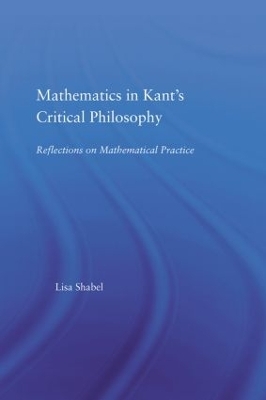
Mathematics in Kant's Critical Philosophy
Routledge (Verlag)
9780415939553 (ISBN)
Mathematics in Kant's Critical Philosophy provides a much needed reading (and re-reading) of Kant's theory of the construction of mathematical concepts through a fully contextualized analysis. In this work Lisa Shabel convincingly argues that it is only through an understanding of the relevant eighteenth century mathematics textbooks, and the related mathematical practice, can the material and context necessary for a successful interpretation of Kant's philosophy be provided. This is borne out through sustained readings of Euclid and Woolf in particular, which, when brought together with Kant's work, allows for the elucidation of several key issues and the reinterpretation of many hitherto opaque and long debated passages.
Lisa Shabel is Assistant Professor of Philosophy at Oho State University.
Preface Introduction PART 1. Euclid: The role of the Euclidean diagram in the Elements 1.0. Euclid: An Introduction 1.1. Characterizing the Euclidean Diagram: Plane Geometry 1.1.1. The Definitions 1.1.2. The Postulates 1.1.3. The Common Notions 1.2. Reading the Euclidean Diagram: Warranting Implicit Assumptions 1.2.1. The Incidence Axioms 1.2.2. The Betweenness Axioms 1.2.3. The Congruence Axioms 1.2.4. The Continuity Axioms 1.2.5. The Parallelism Axiom 1.3. Countering Common Objections to the Euclidean Method 1.4. Characterizing and Reading the Euclidean Diagram: the Arithmetic Books 1.5. The Role of the Euclidean Diagram in Indirect Proof: A Special Case of Pre-Formal Demonstration 1.6. Euclid: Conclusion PART 2. Wolff: The Elementa and Early Modern Mathematical Practice 2.0. Wolff: An Introduction 2.1. Euclid's Elements in the Early Modern Period 2.2. Geometry and Arithmetic in Wolff's Elementa and Other Early Modern Textbooks 2.2.1. Wolff's Mathematical Method 2.2.2. Elementa Geometriae 2.2.3. Elementa Arithmeticae 2.2.4. Early Modern Foundational Views: Descartes and Barrow on the Relationship Between Geometry and Arithmetic 2.3. Algebra and Analysis in Wolff's Elementa: The Tools that Relate Arithmetic and Geometry in the Early Modern Period 2.3.1. Viete and Descartes: The Beginnings of Analytic Geometry 2.3.2. The Construction of Equations as a Standard Topic in Seventeenth and Eighteenth Century Textbooks 2.3.3. Constructing Equations in Wolff's Elementa 2.4. Wolff: Conclusion PART 3. Kant: Mathematics in the Critique of Pure Reason 3.0. Kant: An Introduction 3.1. Pure and Empirical Intuitions 3.1.1. What is a Pure Intuition? 3.1.2. Two Types of Mathematical Demonstration 3.1.3. Pure Intuition and the Synthetic A Priority of Mathematical Judgments 3.1.4. Objections to the Role of Pure Intuition in Mathematical Demonstration 3.2. The Schematism 3.3. Algebraic Cognition 3.3.1. Kant on the Symbolic Construction of Mathematical Concepts 3.3.2. Shared Assumptions: The Prevailing View of Kant on Symbolic Construction 3.3.3. Symbolic Construction: A New Reading 3.4. Kant: Conclusion References Index
| Erscheint lt. Verlag | 16.1.2003 |
|---|---|
| Reihe/Serie | Studies in Philosophy |
| Verlagsort | London |
| Sprache | englisch |
| Maße | 152 x 229 mm |
| Gewicht | 510 g |
| Themenwelt | Geisteswissenschaften ► Philosophie ► Geschichte der Philosophie |
| Geisteswissenschaften ► Philosophie ► Philosophie der Neuzeit | |
| Mathematik / Informatik ► Mathematik ► Logik / Mengenlehre | |
| ISBN-13 | 9780415939553 / 9780415939553 |
| Zustand | Neuware |
| Informationen gemäß Produktsicherheitsverordnung (GPSR) | |
| Haben Sie eine Frage zum Produkt? |
aus dem Bereich


